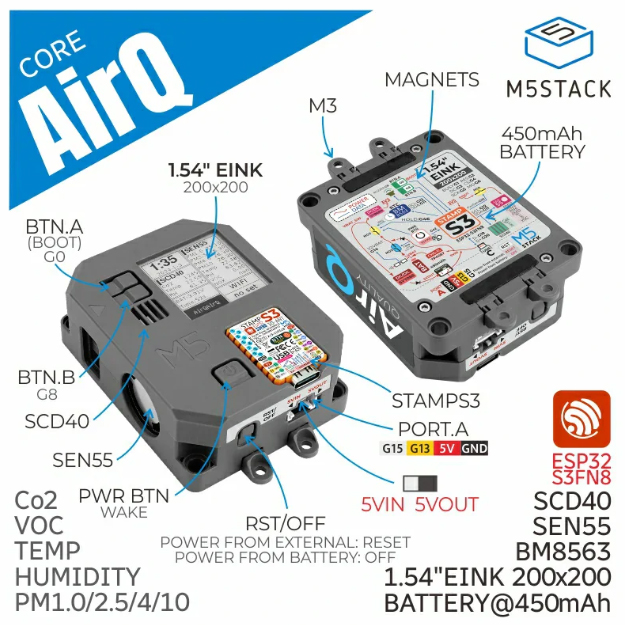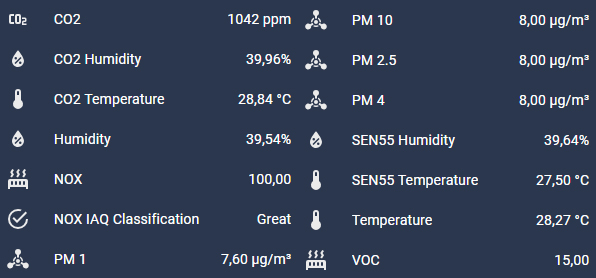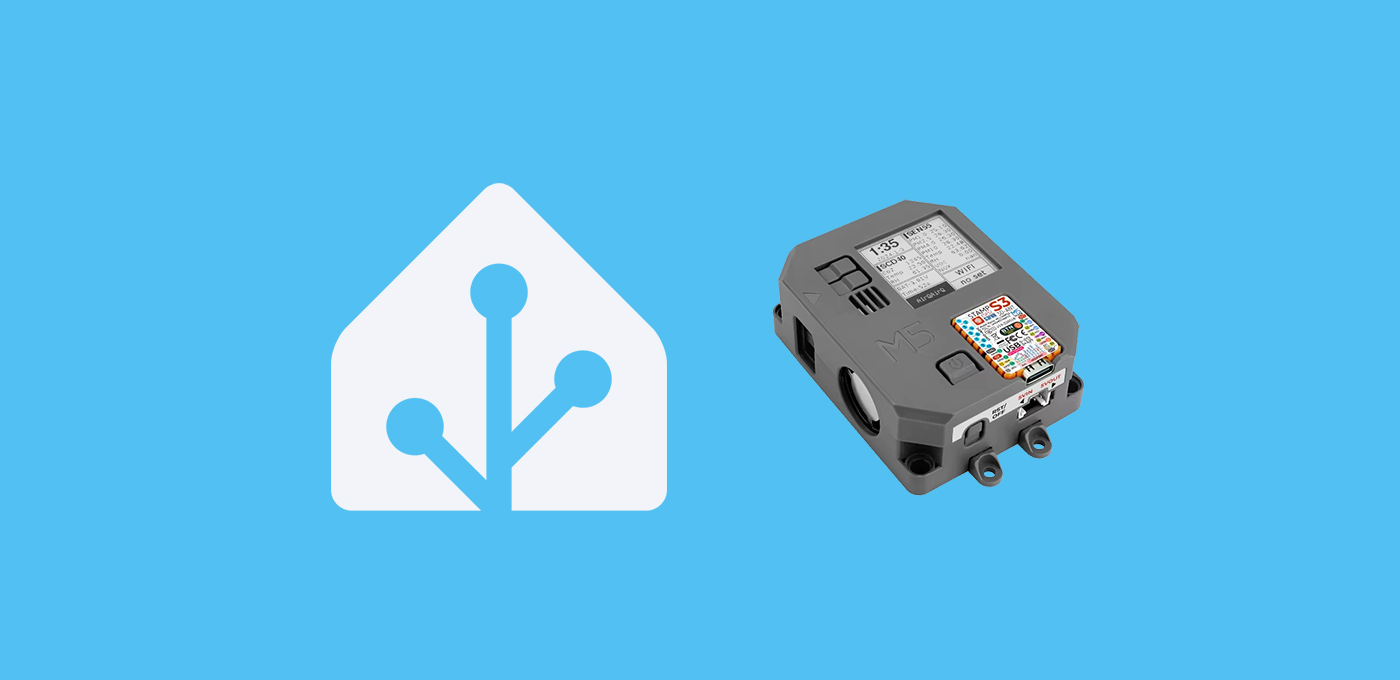En esta entrada vamos a integrar el M5Stack Core AirQ en Home Assistant para tener la información de calidad del aire.
Índice
Sensores de calidad del aire
Aunque es algo que no le inquieta a todo el mundo, cada vez es más frecuente que aquellos que vivimos en grandes ciudades o cerca de zonas industriales nos preocupemos por la calidad del aire en nuestro hogar. Esto no es ninguna tontería y existen muchos estudios, ya que la exposición prolongada a contaminantes puede causar asma, bronquitis y otras enfermedades respiratorias, y a largo plazo, reducir la esperanza de vida y aumentar la incidencia de enfermedades crónicas como el cáncer de pulmón.
En este sentido, la domótica puede ayudarnos a luchar contra sus efectos monitorizando los niveles de calidad del aire, bien para recibir notificaciones cuando se disparen, o para activar dispositivos como sistema de ventilación o purificación del aire. Si lo que te preocupa es, en general, el nivel de contaminación ambiental puedes utilizar integraciones como la de World Air Quality Index.
No obstante, tanto si no te fías de los datos (por ejemplo, porque los medidores se han colocado convenientemente en zonas verdes), como si lo que quieres medir son los datos específicos en tu hogar, tendrás que recurrir a sensores de calidad del aire. Y aquí es donde siempre surge el debate, a la hora de encontrar un sensor completo, integrable y con un precio contenido.
M5Stack Core AirQ
M5Stack ya es una marca conocida para nosotros, por dispositivos como el M5Stack CoreS3SE o el histórico Atom Echo. En este caso vamos a integrar el M5Stack Core AirQ en Home Assistant. Se trata de un dispositivo basado en una placa ESP32S3FN8, con capacidad de medir CO2, VOC, partículas PM1.0, PM2.5, PM4, PM10, temperatura y humedad (aunque según algunas opiniones que he leido, estos dos últimos no son precisos). Además incorpora una pantalla de tinta electrónica y una batería integrada.

Por cierto, en esta entrada vamos a integrar el M5Stack Core AirQ en Home Assistant, pero también podrías usarlo directamente con tu dispositivo móvil para monitorizar sus valores. En el siguiente video se explica el proceso de configuración.
Requisitos previos
Para integrar el M5Stack Core AirQ en Home Assistant necesitas:
- Un M5Stack Core AirQ.
- Haber instalado ESPHome en Home Assistant.
- Un cable USB-C para alimentar la placa de DATOS (con un cable de carga no vas a poder instalar el software).
🥑 Si estás empezando con ESPHome, te recomiendo que veas el taller de la academia para sacarle el máximo partido!Configuración en ESPHome
Sigue estos pasos para integrar el M5Stack Core AirQ en Home Assistant:
- En Home Assistant, ve a tu complemento de ESPHome, pulsa en “New device” y “Continue”.
- Dale un nombre a tu dispositivo (por ejemplo, “AirQ”) y pulsa en “Next”.
- Como tipo de dispositivo selecciona “ESP32-S3”. Observarás de fondo que se ha creado un nuevo bloque para tu dispositivo.
- Pulsa en “Skip” y haz clic en “Edit”, sobre el bloque de tu dispositivo. Copia el código que aparece y consérvalo, ya que vas a necesitar alguna parte del mismo.
- Copia el siguiente código (que encontré en reddit y edité ligeramente) y úsalo para reemplazar el código anterior en ESPHome.
substitutions:
devicename: lounge-airq
friendlyname: Lounge AirQ
location: Lounge
sensor_interval: 10s
esphome:
name: ${devicename}
friendly_name: ${friendlyname}
area: ${location}
platformio_options:
board_build.mcu: esp32s3
board_build.name: "M5Stack StampS3"
board_build.upload.flash_size: 8MB
board_build.upload.maximum_size: 8388608
board_build.vendor: M5Stack
on_boot:
- priority: 800
then:
- output.turn_on: enable
- priority: 800
then:
- pcf8563.read_time
esp32:
board: esp32-s3-devkitc-1 #m5stack-stamps3
variant: esp32s3
framework:
type: arduino
# Enable logging
logger:
# Enable Home Assistant API
api:
encryption:
key: REDACTED
ota:
- platform: esphome
password: REDACTED
wifi:
ssid: !secret wifi_ssid
password: !secret wifi_password
# Enable fallback hotspot (captive portal) in case wifi connection fails
ap:
ssid: "Lounge-Airq Fallback Hotspot"
password: REDACTED
captive_portal:
output:
- platform: gpio
pin: GPIO10
id: enable
web_server:
port: 80
include_internal: true
i2c:
sda: GPIO11
scl: GPIO12
scan: true
frequency: 100kHz
id: bus_a
spi:
clk_pin: GPIO05
mosi_pin: GPIO06
time:
- platform: pcf8563
address: 0x51
update_interval: 10min
- platform: homeassistant
id: esptime
light:
- platform: esp32_rmt_led_strip
rgb_order: GRB
pin: GPIO21
num_leds: 1
rmt_channel: 0
chipset: SK6812
name: "LED"
restore_mode: ALWAYS_OFF
id: id_led
text_sensor:
- platform: wifi_info
ip_address:
name: IP
ssid:
name: SSID
bssid:
name: BSSID
mac_address:
name: MAC
dns_address:
name: DNS
- platform: template
name: "VOC IAQ Classification"
id: iaq_voc
icon: "mdi:checkbox-marked-circle-outline"
lambda: |-
if (int(id(voc).state) < 100.0) {
return {"Great"};
}
else if (int(id(voc).state) <= 200.0) {
return {"Good"};
}
else if (int(id(voc).state) <= 300.0) {
return {"Light"};
}
else if (int(id(voc).state) <= 400.0) {
return {"Moderate"};
}
else if (int(id(voc).state) <= 500.0) {
return {"Heavy"};
}
else {
return {"unknown"};
}
- platform: template
name: "NOX IAQ Classification"
id: iaq_nox
icon: "mdi:checkbox-marked-circle-outline"
lambda: |-
if (int(id(nox).state) < 100.0) {
return {"Great"};
}
else if (int(id(nox).state) <= 200.0) {
return {"Good"};
}
else if (int(id(nox).state) <= 300.0) {
return {"Light"};
}
else if (int(id(nox).state) <= 400.0) {
return {"Moderate"};
}
else if (int(id(nox).state) <= 500.0) {
return {"Heavy"};
}
else {
return {"unknown"};
}
sensor:
- platform: scd4x
co2:
name: CO2
id: CO2
filters:
- lambda: |-
float MIN_VALUE = 300.0;
float MAX_VALUE = 2500.0;
if (MIN_VALUE <= x && x <= MAX_VALUE) return x;
else return {};
temperature:
name: CO2 Temperature
id: CO2_temperature
filters:
- lambda: |-
float MIN_VALUE = -40.0;
float MAX_VALUE = 100.0;
if (MIN_VALUE <= x && x <= MAX_VALUE) return x;
else return {};
humidity:
name: CO2 Humidity
id: CO2_humidity
filters:
- lambda: |-
float MIN_VALUE = 0.0;
float MAX_VALUE = 100.0;
if (MIN_VALUE <= x && x <= MAX_VALUE) return x;
else return {};
altitude_compensation: 0m
address: 0x62
update_interval: $sensor_interval
- platform: wifi_signal # Reports the WiFi signal strength/RSSI in dB
name: "Wifi Signal dB"
id: wifi_signal_db
update_interval: 60s
entity_category: "diagnostic"
- platform: sen5x
id: sen55
pm_1_0:
name: "PM 1"
id: PM1_0
accuracy_decimals: 2
pm_2_5:
name: "PM 2.5"
id: PM2_5
accuracy_decimals: 2
pm_4_0:
name: "PM 4"
id: PM4_0
accuracy_decimals: 2
pm_10_0:
name: "PM 10"
id: PM10_0
accuracy_decimals: 2
temperature:
name: "SEN55 Temperature"
id: sen55_temperature
accuracy_decimals: 2
humidity:
name: "SEN55 Humidity"
id: sen55_humidity
accuracy_decimals: 2
voc:
name: VOC
id: voc
accuracy_decimals: 2
algorithm_tuning:
index_offset: 100
learning_time_offset_hours: 12
learning_time_gain_hours: 12
gating_max_duration_minutes: 180
std_initial: 50
gain_factor: 230
nox:
name: NOX
id: nox
accuracy_decimals: 2
algorithm_tuning:
index_offset: 100
learning_time_offset_hours: 12
learning_time_gain_hours: 12
gating_max_duration_minutes: 180
std_initial: 50
gain_factor: 230
temperature_compensation:
offset: 0
normalized_offset_slope: 0
time_constant: 0
acceleration_mode: low
store_baseline: true
address: 0x69
update_interval: $sensor_interval
- platform: template
name: Temperature
id: temperature
lambda: |-
return (( id(sen55_temperature).state + id(CO2_temperature).state ) / 2 ) - id(temperature_offset).state;
unit_of_measurement: "°C"
icon: "mdi:thermometer"
device_class: "temperature"
state_class: "measurement"
update_interval: $sensor_interval
accuracy_decimals: 2
- platform: template
name: Humidity
id: humidity
lambda: |-
return (( id(sen55_humidity).state + id(CO2_humidity).state ) / 2) - id(humidity_offset).state;
unit_of_measurement: "%"
icon: "mdi:water-percent"
device_class: "humidity"
state_class: "measurement"
update_interval: $sensor_interval
accuracy_decimals: 2
binary_sensor:
- platform: gpio
name: Button A
pin:
number: GPIO0
ignore_strapping_warning: true
mode:
input: true
inverted: true
on_press:
then:
- component.update: disp
- platform: gpio
pin:
number: GPIO08
mode:
input: true
pullup: true
inverted: true
name: Button B
- platform: gpio
pin:
number: GPIO46
ignore_strapping_warning: true
name: Button Hold
- platform: gpio
pin:
number: GPIO42
name: Button Power
button:
- platform: restart
name: Restart
- platform: template
name: "CO2 Force Manual Calibration"
entity_category: "config"
on_press:
then:
- scd4x.perform_forced_calibration:
value: !lambda 'return id(co2_cal).state;'
- platform: template
name: "SEN55 Force Manual Clean"
entity_category: "config"
on_press:
then:
- sen5x.start_fan_autoclean: sen55
number:
- platform: template
name: "CO2 Calibration Value"
optimistic: true
min_value: 400
max_value: 1000
step: 5
id: co2_cal
icon: "mdi:molecule-co2"
entity_category: "config"
- platform: template
name: Humidity Offset
id: humidity_offset
restore_value: true
initial_value: 0.0
min_value: -70.0
max_value: 70.0
entity_category: "CONFIG"
unit_of_measurement: "%"
optimistic: true
update_interval: never
step: 0.1
mode: box
- platform: template
name: Temperature Offset
id: temperature_offset
restore_value: true
initial_value: 0.0
min_value: -70.0
max_value: 70.0
entity_category: "CONFIG"
unit_of_measurement: "°C"
optimistic: true
update_interval: never
step: 0.1
mode: box
display:
- platform: waveshare_epaper
model: 1.54inv2
id: disp
cs_pin: GPIO04
dc_pin: GPIO03
reset_pin: GPIO02
busy_pin:
number: GPIO01
inverted: false
full_update_every: 6
reset_duration: 2ms
update_interval: 10s
lambda: |-
auto now = id(esptime).now().strftime("%H:%M %d/%m/%y").c_str();
it.printf(it.get_width()/2, 0, id(f12), TextAlign::TOP_CENTER, "${location} @ %s", now);
it.print(0, 23, id(f24), TextAlign::TOP_LEFT, "PM 1: ");
it.print(0, 48, id(f24), TextAlign::TOP_LEFT, "PM 2.5: ");
it.print(0, 73, id(f24), TextAlign::TOP_LEFT, "PM 4: ");
it.print(0, 98, id(f24), TextAlign::TOP_LEFT, "PM 10: ");
it.print(0, 123, id(f24), TextAlign::TOP_LEFT, "CO2: ");
it.print(0, 148, id(f24), TextAlign::TOP_LEFT, "VOC: ");
it.print(0, 173, id(f24), TextAlign::TOP_LEFT, "NOX: ");
it.printf(it.get_width(), 23, id(f24), TextAlign::TOP_RIGHT, "%.0f", id(PM1_0).state);
it.printf(it.get_width(), 48, id(f24), TextAlign::TOP_RIGHT, "%.0f", id(PM2_5).state);
it.printf(it.get_width(), 73, id(f24), TextAlign::TOP_RIGHT, "%.0f", id(PM4_0).state);
it.printf(it.get_width(), 98, id(f24), TextAlign::TOP_RIGHT, "%.0f", id(PM10_0).state);
it.printf(it.get_width(), 123, id(f24), TextAlign::TOP_RIGHT, "%.0fppm", id(CO2).state);
it.printf(it.get_width(), 148, id(f24), TextAlign::TOP_RIGHT, "%.0f", id(voc).state);
it.printf(it.get_width(), 173, id(f24), TextAlign::TOP_RIGHT, "%.0f", id(nox).state);
font:
- file:
type: gfonts
family: Noto Sans Display
weight: 500
glyphs: ['&', '@', '!', ',', '.', '"', '%', '(', ')', '+', '-', '_', ':', '°', '0',
'1', '2', '3', '4', '5', '6', '7', '8', '9', 'A', 'B', 'C', 'D', 'E',
'F', 'G', 'H', 'I', 'J', 'K', 'L', 'M', 'N', 'O', 'P', 'Q', 'R', 'S',
'T', 'U', 'V', 'W', 'X', 'Y', 'Z', ' ', 'a', 'b', 'c', 'd', 'e', 'f',
'g', 'h', 'i', 'j', 'k', 'l', 'm', 'n', 'o', 'p', 'q', 'r', 's', 't',
'u', 'v', 'w', 'x', 'y', 'z','å', 'ä', 'ö', '/', 'µ', '³', '’']
id: f16
size: 16
- file:
type: gfonts
family: Noto Sans Display
weight: 500
glyphs: ['&', '@', '!', ',', '.', '"', '%', '(', ')', '+', '-', '_', ':', '°', '0',
'1', '2', '3', '4', '5', '6', '7', '8', '9', 'A', 'B', 'C', 'D', 'E',
'F', 'G', 'H', 'I', 'J', 'K', 'L', 'M', 'N', 'O', 'P', 'Q', 'R', 'S',
'T', 'U', 'V', 'W', 'X', 'Y', 'Z', ' ', 'a', 'b', 'c', 'd', 'e', 'f',
'g', 'h', 'i', 'j', 'k', 'l', 'm', 'n', 'o', 'p', 'q', 'r', 's', 't',
'u', 'v', 'w', 'x', 'y', 'z','å', 'ä', 'ö', '/', 'µ', '³', '’']
id: f18
size: 18
- file:
type: gfonts
family: Noto Sans Display
weight: 500
id: f12
size: 12
glyphs: ['&', '@', '!', ',', '.', '"', '%', '(', ')', '+', '-', '_', ':', '°', '0',
'1', '2', '3', '4', '5', '6', '7', '8', '9', 'A', 'B', 'C', 'D', 'E',
'F', 'G', 'H', 'I', 'J', 'K', 'L', 'M', 'N', 'O', 'P', 'Q', 'R', 'S',
'T', 'U', 'V', 'W', 'X', 'Y', 'Z', ' ', 'a', 'b', 'c', 'd', 'e', 'f',
'g', 'h', 'i', 'j', 'k', 'l', 'm', 'n', 'o', 'p', 'q', 'r', 's', 't',
'u', 'v', 'w', 'x', 'y', 'z','å', 'ä', 'ö', '/', 'µ', '³', '’']
- file:
type: gfonts
family: Noto Sans Display
weight: 500
id: f24
size: 24
glyphs: ['&', '@', '!', ',', '.', '"', '%', '(', ')', '+', '-', '_', ':', '°', '0',
'1', '2', '3', '4', '5', '6', '7', '8', '9', 'A', 'B', 'C', 'D', 'E',
'F', 'G', 'H', 'I', 'J', 'K', 'L', 'M', 'N', 'O', 'P', 'Q', 'R', 'S',
'T', 'U', 'V', 'W', 'X', 'Y', 'Z', ' ', 'a', 'b', 'c', 'd', 'e', 'f',
'g', 'h', 'i', 'j', 'k', 'l', 'm', 'n', 'o', 'p', 'q', 'r', 's', 't',
'u', 'v', 'w', 'x', 'y', 'z','å', 'ä', 'ö', '/', 'µ', '³', '’']
- file:
type: gfonts
family: Noto Sans Display
weight: 500
id: f36
size: 36
glyphs: ['&', '@', '!', ',', '.', '"', '%', '(', ')', '+', '-', '_', ':', '°', '0',
'1', '2', '3', '4', '5', '6', '7', '8', '9', 'A', 'B', 'C', 'D', 'E',
'F', 'G', 'H', 'I', 'J', 'K', 'L', 'M', 'N', 'O', 'P', 'Q', 'R', 'S',
'T', 'U', 'V', 'W', 'X', 'Y', 'Z', ' ', 'a', 'b', 'c', 'd', 'e', 'f',
'g', 'h', 'i', 'j', 'k', 'l', 'm', 'n', 'o', 'p', 'q', 'r', 's', 't',
'u', 'v', 'w', 'x', 'y', 'z','å', 'ä', 'ö', '/', 'µ', '³', '’']
- file:
type: gfonts
family: Noto Sans Display
weight: 500
id: f48
size: 48
glyphs: ['&', '@', '!', ',', '.', '"', '%', '(', ')', '+', '-', '_', ':', '°', '0',
'1', '2', '3', '4', '5', '6', '7', '8', '9', 'A', 'B', 'C', 'D', 'E',
'F', 'G', 'H', 'I', 'J', 'K', 'L', 'M', 'N', 'O', 'P', 'Q', 'R', 'S',
'T', 'U', 'V', 'W', 'X', 'Y', 'Z', ' ', 'a', 'b', 'c', 'd', 'e', 'f',
'g', 'h', 'i', 'j', 'k', 'l', 'm', 'n', 'o', 'p', 'q', 'r', 's', 't',
'u', 'v', 'w', 'x', 'y', 'z','å', 'ä', 'ö', '/', 'µ', '³', '’']
- file:
type: gfonts
family: Noto Sans Display
weight: 500
id: f32
size: 32
glyphs: ['&', '@', '!', ',', '.', '"', '%', '(', ')', '+', '-', '_', ':', '°', '0',
'1', '2', '3', '4', '5', '6', '7', '8', '9', 'A', 'B', 'C', 'D', 'E',
'F', 'G', 'H', 'I', 'J', 'K', 'L', 'M', 'N', 'O', 'P', 'Q', 'R', 'S',
'T', 'U', 'V', 'W', 'X', 'Y', 'Z', ' ', 'a', 'b', 'c', 'd', 'e', 'f',
'g', 'h', 'i', 'j', 'k', 'l', 'm', 'n', 'o', 'p', 'q', 'r', 's', 't',
'u', 'v', 'w', 'x', 'y', 'z','å', 'ä', 'ö', '/', 'µ', '³', '’']
- file:
type: gfonts
family: Noto Sans Display
weight: 500
id: f64
size: 64
glyphs: ['&', '@', '!', ',', '.', '"', '%', '(', ')', '+', '-', '_', ':', '°', '0',
'1', '2', '3', '4', '5', '6', '7', '8', '9', 'A', 'B', 'C', 'D', 'E',
'F', 'G', 'H', 'I', 'J', 'K', 'L', 'M', 'N', 'O', 'P', 'Q', 'R', 'S',
'T', 'U', 'V', 'W', 'X', 'Y', 'Z', ' ', 'a', 'b', 'c', 'd', 'e', 'f',
'g', 'h', 'i', 'j', 'k', 'l', 'm', 'n', 'o', 'p', 'q', 'r', 's', 't',
'u', 'v', 'w', 'x', 'y', 'z','å', 'ä', 'ö', '/', 'µ', '³', '’']
- file:
type: gfonts
family: Noto Sans Display
weight: 800
id: f64b
size: 64
glyphs: ['&', '@', '!', ',', '.', '"', '%', '(', ')', '+', '-', '_', ':', '°', '0',
'1', '2', '3', '4', '5', '6', '7', '8', '9', 'A', 'B', 'C', 'D', 'E',
'F', 'G', 'H', 'I', 'J', 'K', 'L', 'M', 'N', 'O', 'P', 'Q', 'R', 'S',
'T', 'U', 'V', 'W', 'X', 'Y', 'Z', ' ', 'a', 'b', 'c', 'd', 'e', 'f',
'g', 'h', 'i', 'j', 'k', 'l', 'm', 'n', 'o', 'p', 'q', 'r', 's', 't',
'u', 'v', 'w', 'x', 'y', 'z','å', 'ä', 'ö', '/', 'µ', '³', '’']
- file:
type: gfonts
family: Noto Sans Display
weight: 800
id: f55b
size: 55
glyphs: ['&', '@', '!', ',', '.', '"', '%', '(', ')', '+', '-', '_', ':', '°', '0',
'1', '2', '3', '4', '5', '6', '7', '8', '9', 'A', 'B', 'C', 'D', 'E',
'F', 'G', 'H', 'I', 'J', 'K', 'L', 'M', 'N', 'O', 'P', 'Q', 'R', 'S',
'T', 'U', 'V', 'W', 'X', 'Y', 'Z', ' ', 'a', 'b', 'c', 'd', 'e', 'f',
'g', 'h', 'i', 'j', 'k', 'l', 'm', 'n', 'o', 'p', 'q', 'r', 's', 't',
'u', 'v', 'w', 'x', 'y', 'z','å', 'ä', 'ö', '/', 'µ', '³', '’']
- file:
type: gfonts
family: Material Symbols Sharp
weight: 400
id: font_weather_icons_xsmall
size: 20
glyphs:
- "\U0000F159" # clear-night
- "\U0000F15B" # cloudy
- "\U0000F172" # partlycloudy
- "\U0000E818" # fog
- "\U0000F67F" # hail
- "\U0000EBDB" # lightning, lightning-rainy
- "\U0000F61F" # pouring
- "\U0000F61E" # rainy
- "\U0000F61C" # snowy
- "\U0000F61D" # snowy-rainy
- "\U0000E81A" # sunny
- "\U0000EFD8" # windy, windy-variant
- "\U0000F7F3" # exceptional
- file:
type: gfonts
family: Material Symbols Sharp
weight: 400
id: font_weather_icons_small
size: 32
glyphs:
- "\U0000F159" # clear-night
- "\U0000F15B" # cloudy
- "\U0000F172" # partlycloudy
- "\U0000E818" # fog
- "\U0000F67F" # hail
- "\U0000EBDB" # lightning, lightning-rainy
- "\U0000F61F" # pouring
- "\U0000F61E" # rainy
- "\U0000F61C" # snowy
- "\U0000F61D" # snowy-rainy
- "\U0000E81A" # sunny
- "\U0000EFD8" # windy, windy-variant
- "\U0000F7F3" # exceptional
- file:
type: gfonts
family: Open Sans
weight: 700
id: font_clock
glyphs: "0123456789:"
size: 70
- file:
type: gfonts
family: Open Sans
weight: 700
id: font_clock_big
glyphs: "0123456789:"
size: 100
- file: "gfonts://Roboto"
id: font_temp
size: 28
- file:
type: gfonts
family: Open Sans
weight: 500
id: font_small
size: 30
glyphs: "!\"%()+=,-_.:°0123456789ABCDEFGHIJKLMNOPQRSTUVWXYZ abcdefghijklmnopqrstuvwxyz→»"
- file:
type: gfonts
family: Open Sans
weight: 500
id: font_medium
size: 45
glyphs: "!\"%()+=,-_.:°0123456789ABCDEFGHIJKLMNOPQRSTUVWXYZ abcdefghijklmnopqrstuvwxyz→»"
- file:
type: gfonts
family: Open Sans
weight: 300
id: font_xsmall
size: 16
glyphs: "!\"%()+=,-_.:°0123456789ABCDEFGHIJKLMNOPQRSTUVWXYZ abcdefghijklmnopqrstuvwxyz→»"
- Parte importante. En este código no se han incluido las credenciales para que el dispositivo se conecte a tu WiFi y tu instancia de Home Assistant y tienes que incluirlas manualmente. En concreto me refiero a las siguientes líneas del código que has copiado en el paso 4.
# Enable Home Assistant API
api:
encryption:
key: "bg6hash6sjdjsdjk02hh0qnQeYVwm123vdfKE8BP5"
ota:
- platform: esphome
password: "asddasda27aab65a48484502b332f"
wifi:
ssid: !secret wifi_ssid
password: !secret wifi_password
# Enable fallback hotspot (captive portal) in case wifi connection fails
ap:
ssid: "Assist Fallback Hotspot"
password: "ZsasdasdHGP2234"
- Lo que tienes que hacer es, encontrar las líneas correspondientes en el código (está al principio) y añadir la información correspondiente.
- Ahora sí, pulsa en “Save” e “Install”. Selecciona “Manual download” y espera a que se compile el código.
- Cuando termine, selecciona la opción “Modern format” para descargar el fichero ‘.bin’ correspondiente.
- Conecta el M5Stack AirQ con el cable USB-C de datos por el puerto que trae en la parte inferior a tu ordenador.
- Ahora ve a la página de ESPHome y pulsa en “Connect”. En la ventana emergente selecciona tu placa y pulsa en “Conectar”.
- Ahora pulsa en “Install” y selecciona el fichero ‘.bin’ obtenido en el paso 9. De nuevo, pulsa en “Install”.
- Vuelve a Home Assistant y ve a Ajustes > Dispositivos y servicios. Lo normal es que tu dispositivo haya sido descubierto y aparezca en la parte superior, esperando únicamente a que pulses el botón de “Configurar”. De lo contrario pulsa en el botón de “Añadir integración”, busca “ESPHome” e introduce la IP de tu placa en el campo ‘Host’.
Información del dispositivo
Si vas Ajustes > Dispositivos y servicios > ESPHome y seleccionas el dispositivo M5Stack AirQ comprobarás que tienes un montón de entidades con información sobre la calidad del aire.

Además, tambien se han expuesto como entidades los botones que tiene el dispositivo en la parte superior, a la izquierda de la pantalla. Por tanto, puedes crear una automatización para que suceda algo cuando los pulsas. Por ejemplo, que se active tu sistema de ventilación.
Para ello simplemente ve a Ajustes > Automatizaciones y escenas > Crear automatización y, en el apartado «Cuando», añade un disparador de tipo «Estado». En la entidad busca la que corresponda a tu dispositivo (por ejemplo, ‘binary_sensor.airq_button_a’) y en el campo «A» selecciona «Encendido». Después sólo tienes que añadir las acciones deseadas.






















